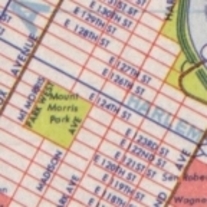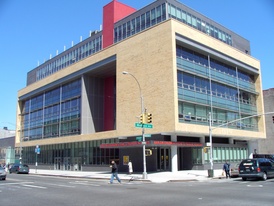Harlem Children's Zone
In the mid 1990s, author and community leader Geoffrey Canada conceived of a new vision for Harlem. After years of hard work with Harlem’s Rheedlen Centers for Children and Families, Canada felt that many children in poor communities were still slipping between the cracks. He decided to create a program that would uplift the entire neighborhood: the Harlem Children’s Zone. Canada's program evolved into a unique organization that serves the children of Harlem with a comprehensive network of education, health, family, and housing programs. Today, the Harlem Community Zone serves a 100-block radius in the community, providing services to 13,000 children through its innovative programs.
Built in 2004, the $44 million Harlem Community Zone headquarters represents the collaboration of Canada and another leader in the African American community: the renowned African American architect, J. Max Bond Jr. Inspired by the local artistry he encountered during a trip to Tunisia as a young man, Bond's architecture integrates allusions to African style in a modernist aesthetic. He has achieved international acclaim for his work on projects such as the Martin Luther King Jr. Center for Non-Violent Change and the Birmingham Civil Rights Institute. Bond also contributed to the World Trade Center Memorial and Columbia University’s Manhattanville project. In a time when black architects make up only 1.5 percent of the American Institute of Architects and black architectural firms receive 85 percent of their commissions from the state, Bond’s achievements are remarkable.
The Harlem Children’s Zone is an excellent example of Bond’s modern aesthetic and belief in architecture’s role in the community. His use of stylistic modernism underscores the Harlem Children’s Zone’s focus on community betterment. Bold colors, dynamic intersecting lines, and asymmetry offer a visual expression of uplift and change. Yet, Bond’s principles of openness and approachability demonstrate that the Harlem Children’s Zone is an integral part of the community. The glass windows that predominate the center’s façade emphasize that the organization is engaged in a dialogue with its community. Likewise, the brick of the community center echoes the use of brick in the commercial buildings, residences, and churches of 125th Street.
This architectural project successfully combines the visions of J. Max Bond Jr. and Geoffrey Canada. The collaboration has produced not only a cultural landmark, but perhaps more significantly, a safe space for Harlem’s children in need.
This entry contributed by a Columbia University student enrolled in Art History W3897, African American Art in the 20th and 21st Centuries, taught by Professor Kellie Jones in 2008.





